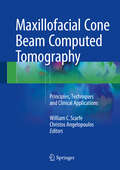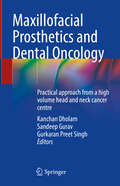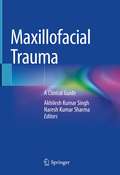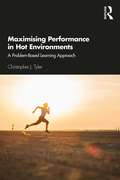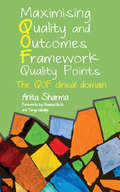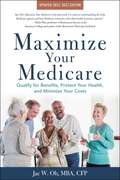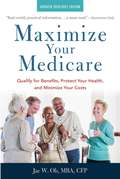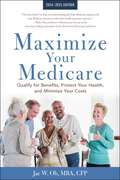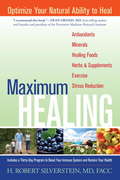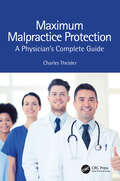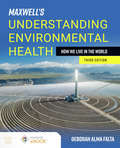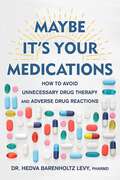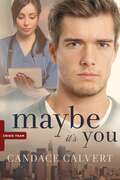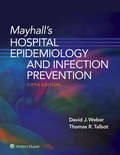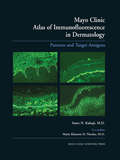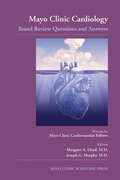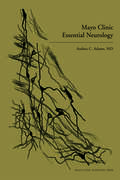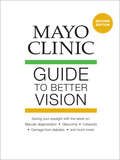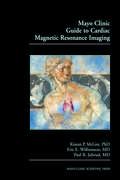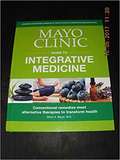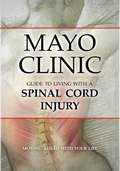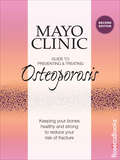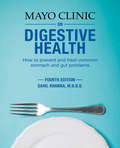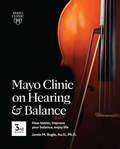- Table View
- List View
Maxillofacial Cone Beam Computed Tomography
by William C. Scarfe Christos AngelopoulosThe book provides a comprehensive description of the fundamental operational principles, technical details of acquiring and specific clinical applications of dental and maxillofacial cone beam computed tomography (CBCT). It covers all clinical considerations necessary for optimal performance in a dental setting. In addition overall and region specific correlative imaging anatomy of the maxillofacial region is described in detail with emphasis on relevant disease. Finally imaging interpretation of CBCT images is presented related to specific clinical applications. This book is the definitive resource for all who refer, perform, interpret or use dental and maxillofacial CBCT including dental clinicians and specialists, radiographers, ENT physicians, head and neck, and oral and maxillofacial radiologists.
Maxillofacial Prosthetics and Dental Oncology: Practical approach from a high volume head and neck cancer centre
by Kanchan Dholam Sandeep Gurav Gurkaran Preet SinghThe book is an assimilation of clinical and practical work done at Tata Memorial Hospital, a prestigious tertiary care cancer hospital in our country. It reflects the evolution of Dental Oncology and Maxillofacial Prosthodontics and more than 33 years of exclusive maxillofacial prosthodontic experience of Dr. Kanchan Dholam. This book covers the clinical guidelines for treatment, based on sound scientific principles and published literature. It also provides a step-by-step approach in the fabrication of commonly-indicated maxillofacial prostheses. It makes an excellent refresher book in Maxillofacial Prosthodontics for all practicing dental post-graduates who want to know more about the subject. The book also contains valuable contributions in Dental Oncology from senior faculty members of the Division of Head and Neck Oncology at Tata Memorial Hospital.This book will be the first Indian/Southeast Asian publication on Dental Oncology and Maxillofacial Prosthodontics. None of the available books have presented a real-world situation of Dental Oncology and Maxillofacial Prosthodontics. This assumes importance in our country wherein the disease presentation is different, cancer treatment is more extensive, and thus the prosthodontic care required, is more challenging and demanding. Apart from the vast socioeconomic difference between patients, the availability of certain materials and techniques is different, which is covered in this book.
Maxillofacial Trauma: A Clinical Guide
by Akhilesh Kumar Singh Naresh Kumar SharmaThis book amalgamates the basic concepts in understanding the science of maxillofacial skeleton with the clinical skills required towards managing complex facial fractures. The book is presented in two sections. The first section introduces the readers with the introduction to maxillofacial trauma, biomechanics of maxillofacial skeleton, the principle of internal fixation, medicolegal aspects of maxillofacial trauma, and preoperative workup which provides a brief outline towards an understanding of the basic concepts about the anatomy and physiology of facial skeleton. The second section is oriented clinically with case-based discussions that start from the emergency management of facial trauma including the recent protocols of basic life support and advanced trauma life support, emergency airway management followed by definitive management guidelines in stabilizing and fixing the fractured facial bones. The clinical cases have been discussed in a way to provide practical knowledge and skills to the postgraduate students and clinicians who will enhance their knowledge and facilitate the decision-making process. This book would be a valuable read for clinicians in oral & maxillofacial surgery, ENT surgery, plastic surgery and allied trauma specialists dealing with maxillofacial trauma.
Maximising Performance in Hot Environments: A Problem-Based Learning Approach
by Christopher J. TylerEnsuring high levels of performance and safety in hot climates is a key consideration for sport scientists and coaches. Maximising Performance in Hot Environments is the first book with a project-based approach to focus solely on exercise in this common climactic condition, providing students and coaches with a clear and concise introduction to working with athletes in the heat. Rigorous in its physiological underpinnings, the book adopts a problem-based learning approach, encouraging students to engage with the science and apply it to practical, real-world scenarios. Posing questions such as "how should athletes be monitored in high temperatures", "what are the ideal conditions for setting a world record in a 10,000m race", and "what special considerations should be made when working with masters athletes", the book covers all key topics, including: The basics of human thermoregulation The effect of high temperatures on performance Heat acclimation and acclimatisation Cooling Hydration Preventing heat-related illness and injury Offering pedagogical features throughout to further enhance student learning, this is a truly innovative and unique resource. It is crucial reading for any student taking classes in environmental physiology, important applied reading for any exercise physiology students, and a vital companion for any sport scientist or coach working with athletes in high temperatures.
Maximising Quality and Outcomes Framework Quality Points: The QOF Clinical Domain (Radcliffe Ser.)
by Anita Sharma'The Quality and Outcomes Framework (QOF) is a system to financially reward general practices for providing quality care to their patients. It is a fundamental part of the GMS contract, introduced in April 2004. QOF is estimated to have saved up to 10,000 lives a year since its introduction - ' - From the Preface Filled with practical guidance and tips, this book explains everything you need to do in order to score 'maximum' on all the clinical indicators in the QOF. Using tables and lists, it details areas such as setting up a disease register, ensuring that you have an accepted definition of the condition, arranging a practice meeting to discuss registers and motivating team members to use and think about templates as well as cross-checking hospital letters and discharges summaries, conducting a repeat prescription search, actively screening at-risk patients and ensuring an efficient call and recall system. These are the basic rules which apply to any and every clinical indicator. Offering guidance on and insight into the origins of different targets, possible shortfalls, and ways to implement change and improve scores, this easy-to-read book is vital for all general practitioners, GP Commissioners, QOF assessors, and PCT QOF teams. Practice nurses, who are often relied upon to maintain QOF standards, will find the information essential. GP Registrars, medical students, Pharmacists, Health Care Assistants and Practice Managers will also find much of interest.
Maximize Your Medicare: Qualify for Benefits, Protect Your Health, and Minimize Your Costs
by Jae Oh"Jae Oh&’s Maximize Your Medicare is the best book I&’ve read on understanding all of the Medicare options and how Medicare intersects with other health insurance options." —Wade Pfau, Professor of Retirement Income at The American CollegeIncludes the Most Up-to-Date Information for 2022-2023 Confused by Medicare? Get answers from Maximize Your Medicare, an informative guide by nationally recognized expert Jae W. Oh. Maximize Your Medicare helps readers understand how and what to choose when deciding on Medicare options. This book shows readers how to: Enroll in Medicare and avoid never-ending penaltiesCompare Medigap vs. Medicare AdvantageDiscern the differences among Parts A, B, and DIncrease benefits every yearAvoid costly errorsDeal with special circumstancesGet the most from the plan Additional information for this new edition includes: Putting it Together: the steps you need to take to be a Savvy Medicare ConsumerNew coverage options for Diabetes and End-Stage Renal Disease patientsHow the ACA enhancements can change your retirement decision-making path Written in a clear and concise style, Maximize Your Medicare is a vital resource for every American aged sixty-five or older, as well as for their families and care coordinators. ged sixty-five or older, as well as for their families and care coordinators.
Maximize Your Medicare: Qualify for Benefits, Protect Your Health, and Minimize Your Costs
by Jae Oh"A must-read for both current and future retirees." —Robert Powell, Retirement Daily Includes the Most Up-to-Date Information for 2020-2021Confused by Medicare? Get answers from Maximize Your Medicare,an informative guide by nationally recognized expert Jae W. Oh. Maximize Your Medicare helps readers understand how and what to choose when deciding on Medicare options. This book shows readers how to:Enroll in Medicare and avoid never-ending penalties Compare Medigap vs. Medicare Advantage Discern the differences among Parts A, B, and DIncrease benefits every yearAvoid costly errorsDeal with special circumstances Get the most from the planWritten in a clear and concise style, Maximize Your Medicare is a vital resource for every American aged sixty-five or older, as well as for their families and care coordinators.
Maximize Your Medicare: Qualify for Benefits, Protect Your Health, and Minimize Your Costs
by Jae Oh"Jae Oh&’s Maximize Your Medicare is the best book I&’ve read on understanding all of the Medicare options and how Medicare intersects with other health insurance options." —Wade Pfau, Professor of Retirement Income at The American CollegeIncludes the Most Up-to-Date Information for 2024-2025 Confused by Medicare? Get answers from Maximize Your Medicare, an informative guide by nationally recognized expert Jae W. Oh. Maximize Your Medicare helps readers understand how and what to choose when deciding on Medicare options. This book shows readers how to: Enroll in Medicare and avoid never-ending penalties Compare Medigap vs. Medicare Advantage Discern the differences among Parts A, B, and D Increase benefits every year Avoid costly errors Deal with special circumstances Get the most from the plan Additional information for this new edition includes: Putting it Together: the steps you need to take to be a Savvy Medicare Consumer New coverage options for Diabetes and End-Stage Renal Disease patients How the ACA enhancements can change your retirement decision-making path Written in a clear and concise style, Maximize Your Medicare is a vital resource for every American aged sixty-five or older, as well as for their families and care coordinators. ged sixty-five or older, as well as for their families and care coordinators.
Maximum Healing
by H. Robert Silverstein Michael B. Teiger Laurence GoldsteinBased on his CAIM (Complementary-Alternative-Integrative-Medicine) approach, Dr. H. Robert Silverstein outlines a program that integrates modern medical practices with alternative and ancient forms of healing. Recalling the work of Andrew Weil and Larry Dossey, the book argues that our self-healing mechanism--the immune system--is more powerful than we think. If we make wise diet and lifestyle changes, says Silverstein, the immune system can function at an optimal level, restoring health and preventing future illnesses.Part I explores the five keys to health--five critical domains that affect the immune system: the quality of our air, water, and food; the degree of physical activity we engage in; and the degree of positive feelings and stability in our psychological and emotional lives. Providing a clear description of the immune system, the book details the elements of good health, which include healing foods, minerals, antioxidants, herbs, physical activity, and the avoidance of unrealistic thinking. Part II contains a thirty-day program divided into four parts: diet, exercise, outlook on life, and creating balance in daily life. The book concludes with over sixty restorative recipes designed to boost immunity and help fight chronic illnesses.From the Trade Paperback edition.
Maximum Malpractice Protection: A Physician’s Complete Guide
by Charles TheislerThe spectre of destructive malpractice lawsuits haunts every practicing doctor who simply wants protection and peace of mind, but most physicians find the world of malpractice confusing and wrapped in legal riddles. This book’s purpose is to explain medical malpractice concepts in everyday terms, combined with solid practical advice to help you: Protect and safeguard your medical career and practice Identify what is and isn't considered malpractice Readily comply with all legal duties required of doctors Prevent malpractice allegations and minimize liability Take control to protect assets, and minimize personal and professional losses Work with your attorneys to establish the best possible defense Walk through each clinical aspect of the patient encounter from the perspective of a malpractice attorney
Maxwell's Understanding Environmental Health: How We Live in the World
by Deborah Alma FaltaOffering a unique approach to presenting environmental health, Maxwell's Understanding Environmental Health: How We Live in the World is structured around the choices we make as individuals that result in environmental hazards. By detailing the hazards of energy production, industry, food production, and our modern lifestyle in the context of our place within the local and global community, the author tells a connected narrative that makes the text both engaging and accessible to a broad range of students with a variety of scientific backgrounds Updated thoroughly, the Third Edition offers: Full color design that brings charts, graphs, and photos to life. New chapter on managing environmental health risks, New appendix provides an overview of the U.S. Regulatory Framework for Environmental Health.
Maybe It's Your Medications: How to Avoid Unnecessary Drug Therapy and Adverse Drug Reactions
by Dr. Hedva Barenholtz Levy PharmDAdults ages 65+: Your medication could be the reason for your new medical condition; read this eye-opening guide to become an expert on what medications you take!We have a medication problem in America. It is marked not only by excessive use of medications, but by errors in how they are prescribed, monitored, and taken. An estimated nineteen million adults age sixty-five and older take five or more medications daily. These individuals and family caregivers know the frustrations of lengthy medication lists, high drug costs, and frequent questions about the need and value of those medications. All too often, an unrecognized adverse drug effect is mistaken for a new medical condition, or worse, a symptom of getting older. But who stops to question the medications?Maybe It&’s Your Medicationstackles these problems by providing information, insider tips, and strategies that empower patients and caregivers to have important conversations about their prescription and nonprescription drugs. This book addresses the questions consumers want to ask about their medications and brings to light other questions they should be asking but may not know how. It is everyone&’s go-to guide on how to use medications safely on the journey to healthy aging. Dr. Hedva Barenholtz Levy, PharmD, is a geriatric specialist and founder of a unique senior care practice of over 25 years working with patients in their homes. She is an educator and leader in geriatric pharmacy and a dual board-certified specialist. Dr. Levy applies her decades of experience to guide the reader in how to become an active participant on their healthcare team and prevent unintended errors and medication-related problems.
Maybe it's You (Crisis Team Ser. #3)
by Candace CalvertNurse Sloane Ferrell escaped her risky past—new name, zip code, job, and a fresh start. She’s finally safe, if she avoids a paper trail and doesn’t let people get too close. Like the hospital’s too-smooth marketing man with his relentless campaign to plaster one “lucky” employee’s face on freeway billboards. Micah Prescott’s goal is to improve the Hope hospital image, but his role as a volunteer crisis responder is closer to his heart. The selfless work helps fill a void in his life left by family tragedy. So does a tentative new relationship with the compassionate, beautiful, and elusive Sloane Ferrell. Then a string of brutal crimes makes headlines, summons responders . . . and exposes disturbing details of Sloane’s past. Can hope spring from crisis? CANDACE CALVERT is a former ER nurse and author of the Mercy Hospital, Grace Medical, and Crisis Team series. Her medical dramas offer readers a chance to “scrub in” on the exciting world of emergency medicine. Wife, mother, and very proud grandmother, Candace makes her home in northern California. Please visit her website at www.candacecalvert.com.
Mayhall’s Hospital Epidemiology and Infection Prevention
by David Weber Tom TalbotThe fifth edition of Mayhall’s Hospital Epidemiology and Infection Prevention has a new streamlined focus, with new editors and contributors, a new two-color format, and a new title. Continuing the legacy of excellence established by Dr. C. Glen Mayhall, this thoroughly revised text covers all aspects of healthcare-associated infections and their prevention and remains the most comprehensive reference available in this complex field. It examines every type of healthcare-associated (nosocomial) infection and addresses every issue relating to surveillance, prevention, and control of these infections in patients and in healthcare personnel, providing unparalleled coverage for hospital epidemiologists and infectious disease specialists.
Mayo Clinic Atlas of Immunofluorescence in Dermatology: Patterns and Target Antigens
by Amer N. Kalaaji Marie E.O. NicolasFilling a gap in the literature, this atlas stands as a unique authoritative source to thoroughly review the many immunofluorescence patterns seen in immunodermatology for conditions such as immunobullous diseases, connective tissue diseases, vasculitis, and other miscellaneous dermatologic disorders.
Mayo Clinic Cardiology: Board Review Questions and Answers
by Margaret A. Lloyd Joseph G. MurphyFocus on the right questions for the cardiology boards and recertification exam with the latest addition to the popular Mayo Clinic board review collection. Easy-to-use and organized by sections, this book includes more than 650 board-focused questions, full-color illustrations and explained answers focused on cutting-edge knowledge of accepted diagnostic methods, pharmacotherapy, and interventional, and non-interventional treatment options. Use this book to sharpen your board knowledge skills and improve your score. For further study and reference, use this book with the Mayo Clinic Cardiology Concise Textbook, Third Edition-a special value course pack is also available.
Mayo Clinic Essential Neurology
by Andrea C. AdamsMayo Clinic Essential Neurology covers the full scope of neurology by combining a focused need-to-know format with core basics along with diagnosis and treatment guidelines. More than 75 color illustrations and numerous therapeutic tables help residents and clinicians diagnose, treat, and manage the most commonly encountered neurologic problems. To
Mayo Clinic Guide to Better Vision: Saving Your Vision with the Latest on Macular Degeneration, Glaucoma, Cataracts, Damage from Diabetes, and Much More!
by Mayo ClinicA handbook on eye health from&“one of the most reliable, respected health resources that Americans have&” (Publishers Weekly). The eye is as intricate as the latest computer and as precious as any jewel. While eye disease is rarely fatal, eye health is essential to enjoyment of your world as you know it. So it makes sense to give your eyes the attention and care they richly deserve. With more people living longer lives, age-related eye disease has become more common. Fortunately, state-of-the-art medical treatment has not only kept up but made great advances. So has our understanding of the nutritional and lifestyle decisions that impact vision and eye health. Mayo Clinic helps thousands of patients each year with vision and eye problems, and its medical staff includes some of the finest eye doctors in the world. Now you can take advantage of this wealth of knowledge. In Mayo Clinic Guide to Better Vision, you&’ll learn: · 8 ways to prevent macular degeneration, the age-related eye disease that causes vision loss and blind spots · 5 ways to prevent glaucoma, the &“silent thief of sight&” that commonly develops with no warning signs · 8 self-care tips to help you or a loved one keep your diabetes under control and effectively slow the progression of diabetic retinopathy · 4 steps that may slow or prevent the development of a cataract Mayo Clinic Guide to Better Vision covers all the leading causes of vision loss, with practical information on prevention, detection, and treatment—all based on the same medical knowledge Mayo Clinic doctors share with their patients.
Mayo Clinic Guide to Cardiac Magnetic Resonance Imaging
by Kiaran P. McGee Eric E. Williamson Paul R. JulsrudThis compact guide to cardiac magnetic resonance imaging incorporates the most common techniques with easy-to-follow step-by-step protocols. Physicians and technicians alike get quick access to the information they need at the point of exam. Features include:A review of the most common cardiac MR imaging planes with step-by-step protocolsAn overvie
Mayo Clinic Guide to Integrative Medicine: Conventional Remedies Meet Alternative Therapies to Transform Health
by Brent A. Bauer Mayo Clinic Staff Stewart J. Koski Kent McDaniel Matthew C. Meyer Gunnar T. Soroos Malgorzata B. WeivodaMAYO CLINIC Guide To INTEGRATIVE MEDICINE
Mayo Clinic Guide to Living with a Spinal Cord Injury: Moving Ahead with Your Life
by Mayo ClinicFrom doctors and health professionals at the Mayo Clinic Spinal Cord Injury Program, this guide provides basic information to those who have suffered a spinal cord injury. It contains advice on many aspects of dealing with living with the injury, including emotional adjustment, changes to body functions and ways to prevent problems, sexual health and fertility, managing independence and hiring a personal care assistant, nutrition, exercise, substance abuse, going back to work, traveling, and actively participating in life. There is no bibliography.
Mayo Clinic Guide to Preventing & Treating Osteoporosis: Keeping Your Bones Healthy and Strong to Reduce Your Risk of Fracture
by Mayo ClinicExpert information on preventing brittle bones and staying active and independent. Thanks to advances at the world-renowned Mayo Clinic and elsewhere, osteoporosis, the brittle bone disease that contributes to premature aging, can be effectively managed or even avoided. We no longer have to tolerate the pain and disability osteoporosis once caused. That's just the start of the good news you'll find in this newly updated edition of Mayo Clinic Guide to Preventing and Treating Osteoporosis. This book brings you a take-charge approach to preventing, diagnosing, and managing osteoporosis. You'll find detailed guidance to promote better bone health through diet, supplements, exercise, medications and more: · Learn how to reduce your risk of fracture due to falling · Read about the role of good posture, fitness, balance and coordination · Discover the good news on the latest advances in medications for osteoporosis · Learn how to choose the treatment options that are best for you These strategies, together with support from others and the guidance of your personal physician, can offer you the best opportunity to prevent bone loss and continue to live an active, full, and independent life.
Mayo Clinic Internal Medicine Concise Textbook
by Thomas M. Habermann Amit K. GhoshNow for the first time, a new diagnosis and treatment guide with even more focus on the most commonly encountered disorders than ever before. All major internal medicine diseases and disorders are covered in this new succinct evidence-based guide to treatment and diagnosis in internal medicine. Organized by body system, and focused on critical cor
Mayo Clinic on Digestive Health: How to Prevent and Treat Common Stomach and Gut Problems (Mayo Clinic On Health Ser.)
by Sahil KhannaDigestive problems are among the most common reasons people see their doctors. They&’re also a leading reason why people take medication. Mayo Clinic on Digestive Health, fourth edition, is an authoritative, yet practical reference manual that includes information on everything from healthy digestion to cancer treatment. The book is packed with helpful advice about how to maintain a healthy gut; manage heartburn, gas, constipation and diarrhea; treat several common digestive conditions; and prevent serious disease. The book provides guidance and helpful tips on a variety of digestive conditions, including: Belching, bloating and gas Celiac disease Colorectal cancer Constipation and diarrhea Crohn&’s disease and ulcerative colitis Diverticular disease Gallbladder disease Heartburn and GERD Irritable bowel syndrome Liver disease Pancreatic disease Swallowing difficulties Ulcers and stomach pain
Mayo Clinic on Hearing and Balance: Hear Better, Improve Your Balance, Enjoy Life
by Jamie M. BogleMayo Clinic on Better Hearing and Balance, 3rd edition, offers practical advice for managing issues with hearing and balance, two of the most common reasons people visit their doctors – especially as they age. Problems with hearing and balance can cause a host of struggles and can have a variety of causes. Mayo Clinic on Better Hearing and Balance helps readers understand the possible causes of hearing and balance issues and offers solutions aimed at improving not just hearing and balance, but quality of life overall. In this book, you'll get the answers to many common questions about hearing and balance, including: how hearing and balance are tested, ways you can protect your hearing, what you can do to improve your balance, how underlying causes of hearing loss are treated, ways to live well with hearing loss and balance issues, and how to select hearing aids and cochlear implants. You&’ll also gain real-life insight from people who are successfully managing hearing loss and balance issues.
